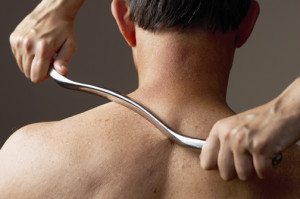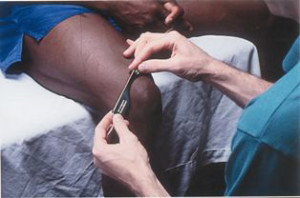
What is the Graston Technique ®

The Graston Technique is a highly effective treatment in the world of physical therapy helping to decrease pain and improve function. Even world class athletes, like Olympian Gold Medalist Michael Phelps, are big-time believers in it.
Physical therapists have an innovative set of tools to help improve treatment of soft tissue injuries. A form of Instrumented Assisted Soft Tissue Mobilization (IASTM), Graston Technique therapy involves a set of stainless steel instruments in varying sizes being combed over painful areas until the adhesions causing the pain are broken down and absorbed into the body.
As part of the healing process, our bodies attempt to repair those areas by creating scar tissue, similar to the scar you see when you scrape your skin. Graston treatment is a revolutionary procedure that allows physical therapists to easily detect and treat areas of scar tissue in muscles, tendons and ligaments that may be reducing your range of motion and causing pain.
NJ Physical Therapy: Top Five Things You Should Know About the Graston Technique
The NJ physical therapy services from AOSMI consists of a unique a specialized treatment option called the Graston Technique. Here are the top things you know to know:

1. With age, you may experience dysfunction in your body
With time, our muscles, tendons and ligaments get a lot of use. This can lead to a buildup of fibrous scar tissue. This replacement tissue lacks the strength and flexibility of healthy tissue, which can cause pain.
2. Graston treatment can help.
When it comes to physical therapy, Graston treatment provides many benefits. The instruments used as part of the Graston Technique allow the physical therapist to follow the kinetic chain of connecting tissue, effectively uncovering the cause of the problem, allowing them to treat the precise area of pain. The Graston Technique has been effective in the treatment of:
- carpal tunnel syndrome
- cervical pain
- lower back pain
- muscle strain
- tendinosis
- post-fracture pain
- painful scars
- de Quervain’s syndrome
- epicondylosis
- fibromyalgia
- IT band syndrome
- joint sprain
- plantar fasciitis
- women’s health (post-mastectomy and Caesarean scarring)
3. The instruments used are revolutionary.

Graston Technique therapy allows for better detection and treatment using stainless steel instruments that glide along your muscle, tendons or ligaments. Much like tuning forks, these instruments resonate in the provider’s hands allowing him or her to isolate adhesions and restrictions, and treat them very precisely. With the right amount of pressure, they can detect exactly where scar tissue or restrictions are located. When these bands of scar tissue are found, both you and your therapist will sense a restriction, similar to a speed bump. At this point, the instrument is used to break up this restriction. Stretching exercises are also incorporate to promote re-alignment of the fibers into the normal pattern of healthy tissue.
4. You must follow care instructions.
Commitment to a home exercise regimen is essential to the success of your Graston treatment. Your physical therapist may prescribe stretching and strengthening exercises, which help maintain the release of scar tissue, restrictions and adhesions. Also, since proper hydration is an important part of the healing process, you should try to drink six to eight 8-oz. glasses of water per day.
5. There are a few possible side effects.
When scar tissue binds with your normal tissue, a blood supply is developed. As restrictions are released from healthy tissue, you may notice some skin redness. While bruising may occur, it’s usually a sign that the provider was much too aggressive. Ice packs can help control the amount of bruising. In addition, you may experience soreness and discomfort after your first Graston treatment session, but don’t worry, this is a sign that restrictions have been released. Your soreness will typically fade after 48 to 72 hours and can be minimized with stretching and ice.
You don’t have to live with pain and discomfort. If you think this technique may work for you, or you’re currently undergoing standard physical therapy, Graston treatment may be a better solution. Check out the provider list at grastontechnique.com to start your pain-free life today.







